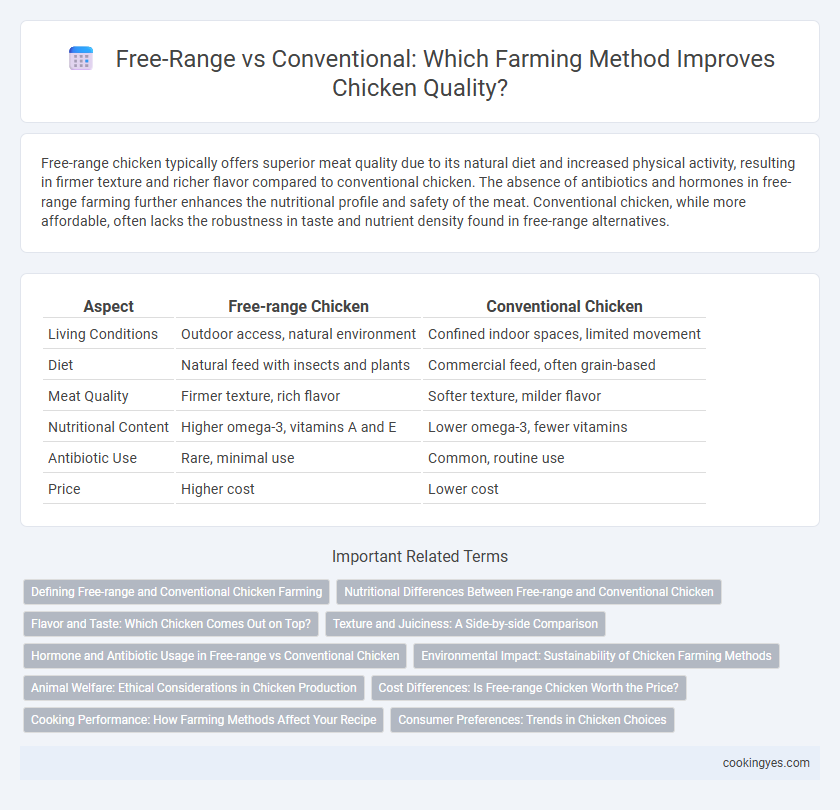Free-range chicken typically offers superior meat quality due to its natural diet and increased physical activity, resulting in firmer texture and richer flavor compared to conventional chicken. The absence of antibiotics and hormones in free-range farming further enhances the nutritional profile and safety of the meat. Conventional chicken, while more affordable, often lacks the robustness in taste and nutrient density found in free-range alternatives.
Table of Comparison
| Aspect | Free-range Chicken | Conventional Chicken |
|---|---|---|
| Living Conditions | Outdoor access, natural environment | Confined indoor spaces, limited movement |
| Diet | Natural feed with insects and plants | Commercial feed, often grain-based |
| Meat Quality | Firmer texture, rich flavor | Softer texture, milder flavor |
| Nutritional Content | Higher omega-3, vitamins A and E | Lower omega-3, fewer vitamins |
| Antibiotic Use | Rare, minimal use | Common, routine use |
| Price | Higher cost | Lower cost |
Defining Free-range and Conventional Chicken Farming
Free-range chicken farming allows birds access to outdoor spaces, promoting natural behaviors and resulting in leaner meat with a distinct flavor profile. Conventional chicken farming confines birds to indoor environments with controlled temperature and lighting, optimizing growth rates but often limiting animal welfare. These differing conditions directly influence the texture, taste, and nutritional quality of the chicken produced.
Nutritional Differences Between Free-range and Conventional Chicken
Free-range chicken typically contains higher levels of omega-3 fatty acids and vitamin E compared to conventional chicken, due to their varied diet and outdoor access. Conventional chicken often has more saturated fat and lower micronutrient density as a result of grain-based feed and confined living conditions. Studies also show free-range chicken meat tends to have improved protein quality and enhanced antioxidant properties.
Flavor and Taste: Which Chicken Comes Out on Top?
Free-range chicken typically offers a richer, more robust flavor compared to conventional chicken due to its varied diet and active lifestyle, which enhances muscle development and fat distribution. Conventional chicken often has a milder taste and softer texture because of controlled feed and limited movement. Consumers seeking a more intense, natural taste frequently prefer free-range chicken for culinary dishes.
Texture and Juiciness: A Side-by-side Comparison
Free-range chicken typically offers improved texture with firmer muscle fibers and enhanced juiciness due to increased physical activity and natural diet. Conventional chicken often has a softer texture but may lack the richer juiciness found in free-range varieties because of limited movement and controlled feed. Consumers seeking superior mouthfeel and moisture retention frequently prefer free-range chicken for its balanced tenderness and flavor profile.
Hormone and Antibiotic Usage in Free-range vs Conventional Chicken
Free-range chicken typically contains lower levels of antibiotics and hormones compared to conventional chicken, as free-range farming restricts or eliminates their use to promote natural growth. Conventional chickens are often raised with routine antibiotic treatments to prevent disease in crowded conditions, increasing the risk of antibiotic residues and resistance. This difference impacts the overall quality and safety of the meat, with free-range chicken favored by consumers seeking hormone-free and antibiotic-free options.
Environmental Impact: Sustainability of Chicken Farming Methods
Free-range chicken farming typically offers a lower environmental footprint compared to conventional methods by reducing reliance on intensive feed production and promoting natural foraging, which enhances soil health and biodiversity. Conventional chicken farming often results in higher greenhouse gas emissions and greater resource consumption due to concentrated animal feeding operations (CAFOs) and waste management challenges. Sustainable poultry farming prioritizes practices that balance animal welfare and ecosystem preservation, making free-range systems more aligned with environmental sustainability goals.
Animal Welfare: Ethical Considerations in Chicken Production
Free-range chicken production prioritizes animal welfare by allowing birds access to outdoor areas, promoting natural behaviors and reducing stress, which can lead to improved meat quality. Conventional chicken farming often confines birds in crowded indoor spaces, raising ethical concerns about animal suffering and limited mobility. Enhanced welfare standards in free-range systems align with consumer demand for ethically sourced poultry and support sustainable farming practices.
Cost Differences: Is Free-range Chicken Worth the Price?
Free-range chicken typically costs 20-40% more than conventional chicken due to higher land use, feed, and labor expenses associated with natural grazing environments. While free-range chicken offers improved flavor, texture, and potentially higher nutrient levels like omega-3 fatty acids, the price premium reflects these quality benefits and ethical considerations. Consumers weigh the enhanced welfare standards and perceived health benefits against the increased cost, determining whether free-range chicken justifies the investment based on personal values and budget constraints.
Cooking Performance: How Farming Methods Affect Your Recipe
Free-range chicken typically offers a firmer texture and richer flavor due to increased muscle activity and natural diet, resulting in more consistent browning and juiciness during cooking. Conventional chicken, often higher in fat and moisture, tends to cook faster but can risk dryness if overcooked, affecting recipe outcomes. Understanding these differences helps optimize cooking times and methods for better taste and texture in your dishes.
Consumer Preferences: Trends in Chicken Choices
Consumer preferences increasingly favor free-range chicken due to perceived benefits in taste, texture, and animal welfare standards compared to conventional chicken. Market data shows a steady rise in demand for free-range poultry, driven by health-conscious buyers and ethical consumption trends. Retail sales indicate that premium pricing for free-range chicken reflects its growing popularity among environmentally and quality-focused consumers.
Free-range vs Conventional for Chicken Quality Infographic

 cookingyes.com
cookingyes.com